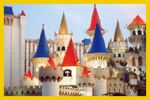

Death Valley
Death
Valley is located 120 miles west of
Las Vegas at the California/Nevada
border.
It is the lowest point in the western hemisphere and the second
lowest in the world, at 282 ft below sea level (at Badwater). The highest
point is Telescope Peak, 11,049 ft. One hundred fifty miles long and twenty
miles wide, Death Valley has the hottest temperature on Earth, with a
record of 134°F on July 10, 1913. (The highest temperature on Earth
was recorded at Al'Aziziyah, Libia, on September 13, 1922: 136.4°F.)
Death Valley is also the driest place in the US; the average rainfall
is under two inches per year, and some years it does not rain at all.
Death Valley, once described as "the nearest to a little hell on Earth the wickedest world can produce," is a geologist's dream. The oldest rocks are 1,800 million years old. There is almost no soil or vegetation in most parts, yet Death Valley is home to 37 reptile species, 6 types of amphibians, 58 species of mammals, and 347 species of birds. Fish, the tiny, rare pupfish, can be seen in Salt Creek. Some 600 desert bighorn live in the mountains. More than 900 plant species can be found in this "Godforsaken country."
Badwater is the lowest point in the Western hemisphere: 282 ft below sea level. The site's name comes from a surveyor's map on which he penned "bad water" because his mule refused to drink water from the salty spring.
One million tourists visit Death Valley National Park (3.3 million acres) every year.
Beatty is one of the eastern portals to Death Valley National Park. The Beatty Information Center has information and exhibits about Death Valley natural history, cultural history, and scenic routes.
Selected sites to visit:
- Scotty's Castle (Death Valley Ranch)
- Rhyolite
- Furnace Creek and its Visitor Center and museum
- Salt Creek
- Badwater
![]() See
also www.furnacecreekresort.com.
See
also www.furnacecreekresort.com.